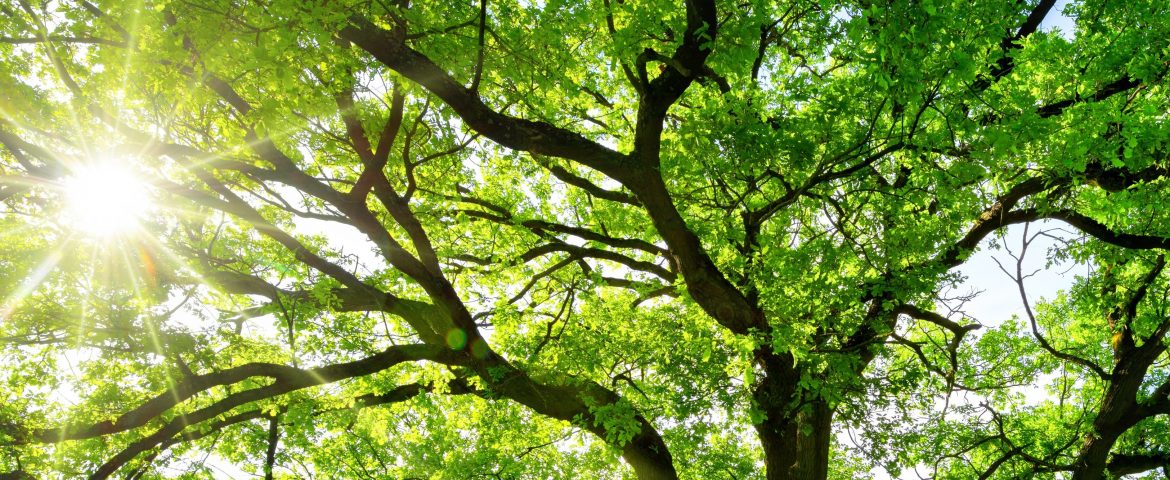By: Melinda Jones, ReLeaf Michigan Executive Director
While it’s well established that trees provide aesthetic, economic, social and environmental benefits, compelling new research is showing trees also provide significant health benefits to their communities in a variety of powerful ways. Trees are natural and efficient problem solvers that improve air quality, reduce stress and build healthier communities.
Improved physical health
Exposure to air pollution is associated with a wide range of human health issues, including increased respiratory problems, hospitalization due to heart or lung diseases, and even premature death. As many people know, trees improve regional air quality by absorbing nitrogen dioxide, carbon monoxide, ozone, and particulate matter from the atmosphere and produce oxygen for us to breathe. But trees do much more for our health than clean the air.
Trees also reduce the urban heat island effect, which occurs when buildings and roads replace once permeable, natural land. Impervious materials like concrete and pavement are dry and reflect heat, making urban areas warmer than the surrounding rural landscape. The consequences of increasing impervious surfaces in urban areas are dire. The EPA estimates that there are nearly 1,300 heat related deaths in the United States each year, and a 2019 study suggests that without the existing urban tree canopy, that number would double. Planting and maintaining urban trees (core to ReLeaf Michigan’s mission) are critical activities, now more than ever, as global temperatures continue to rise. Further, trees offer protection from harmful UV rays by providing shade.
Another surprising benefit is that trees actually encourage us to go outside and partake in physical activity. One study found that residents of areas with the highest levels of greenery were three times more likely to be physically active and 40% less likely to be overweight or obese than residents living in the least green settings. Another study found that a 10% increase in neighborhood tree cover resulted in a 19% reduction in obesity.

Restored mental health
Trees offer us an amazing way to restore our minds from the mental fatigue that we experience regularly from activities such as work, raising families, studying, and more. Cognitive fatigue occurs after periods of intense concentration or directed attention. Mental fatigue can lead to irritability, lack of concentration, inability to solve problems, and increased likelihood of making mistakes or causing accidents.
In fact, new research reports that people are significantly more likely to report good health and well-being in a wide variety of metrics if they simply spend 120 minutes or more in nature each week, causing publications such as the Wall Street Journal to wonder if spending two hours outdoors is “the new 10,000 steps.” A different study also showed that park users reported lower levels of anxiety and sadness after visiting parks, with benefits increasing the longer the person spent in the park. Simply looking at trees was shown to lower stress within five minutes, as indicated by changes in blood pressure and muscle tension.
Health impacts directly related to children
Asthma is the leading chronic disease in children, and the occurrence of asthma has been increasing since the 1980’s in all age, sex, and racial groups. As previously described, trees filter airborne pollutants that cause asthma and other respiratory problems. Research out of New York City found that asthma rates were highest in areas of the city with the lowest tree density. The rate of asthma fell by 29% for every extra 343 trees per square kilometer, a pattern that held true even after taking account of differing sources of pollution, levels of affluence and population density.
Children with attention deficit disorder have also been shown to function better after activities in green settings. Playing outside in a green environment helps lessen symptoms, and a walk in the park has even been shown to have equivalent effects as two typical ADHD medications.
With the health benefits of trees becoming more understood, some doctors are even beginning to prescribe walks in the woods for their patients. Make time to visit your local park for a wellness check today to appreciate all that trees do to make us healthy.
About the author: For the past 20 years Melinda Jones has worked as a consulting forester and the executive director of ReLeaf Michigan, the only statewide non-profit tree planting and education organization in Michigan. She has served on the executive board of the International Society of Arboriculture (ISA) and was the 2018 recipient of the ISA Sharon Lilly Award of Distinction. Melinda holds a degree in Forestry from Michigan State University and has more than 45 years of experience in the Green Industry.


